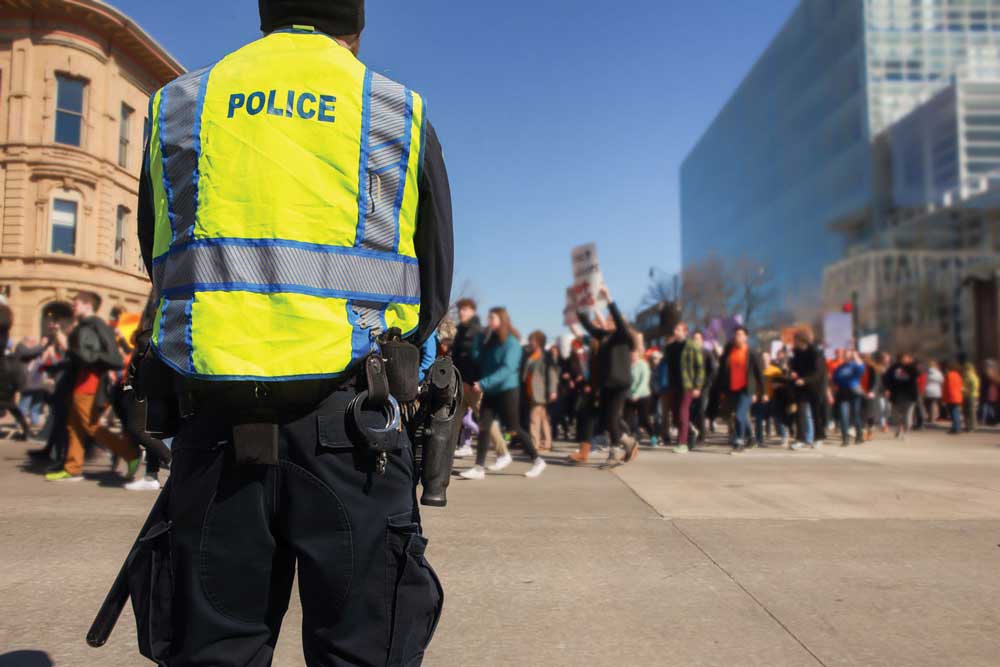
An overview of critical preparedness issues and key lessons by Schaenman and Stambaugh.
By Philip Schaenman and Hollis Stambaugh
“Hope for the best, prepare for the worst.” This mantra of Jack Reacher in Lee Child’s novels is a good philosophy for city managers as well.
While statistically unlikely to happen in your city, mass shootings are occurring in many jurisdictions. The August 2018 PM magazine article, “Dealing with Terrorist Threats,” outlined a general approach to preparing for mass shootings and other mass casualty events. This article provides key lessons for city managers learned from actual mass shootings. The authors drew from more than 50 major incident after-action investigations they directed, including the mass shootings at Columbine High School, Virginia Tech University, and the Aurora, Colorado, movie theater, as well as the Boston Marathon bombing.
City managers must rely on the professionalism of each city department that plays a key role in preparedness: police training for active shooters; fire/EMS training for triage and transport for mass casualty incidents (MCIs); emergency management departments that support other agencies with resources and victim assistance; public information management for timely, accurate communication; and others. City managers should meet with each department to review its role in an MCI, including completed training, on-site equipment, as well as the need for additional must-have items, and how it is organized to coordinate with counterparts in and near the jurisdiction.
10 Critical Issues
We next focus on 10 multi-departmental issues in preparedness - the hard-won lessons learned from the aforementioned 50+ major incident after-action reports.
1. Emergency alert system.
Do you have a multilayered emergency alert system designed to communicate crisis alerts and instructions to the public so you can reach almost everyone? Think emergency announcements by radio, TV, telephone tree, email, social media, mobile and fixed electronic boards, CCTV, even vehicles with megaphones. Can warnings be received by the hearing impaired or followed by the visually or mobility impaired? Have you established protocols for triggering an alert if you are absent, or if time is of the essence? Sometimes an alert is needed just for the immediate area of an incident, and sometimes for the whole community. In one mass shooting, there was a delay in getting radio and TV to spread the word because only one person had the code to authenticate the message. Many Virginia Tech students were not aware that there was an active shooter on campus after the initial dormitory shootings occurred. Most residents of Watertown, Massachusetts, were not aware that police were exchanging gunfire with suspects and that a Boston Marathon terrorist was later on the loose.
2. Regional coordination of mutual aid.
Few communities can stand on their own responding to an MCI. Even New York City on 9/11 had to rely on volunteer units from Long Island to fill in fire stations and lend fire equipment.
Make sure you have arrangements with neighboring communities to assist with police, fire, and EMS units; practice occasionally with them. They may assist not only in direct mitigation, but also in backfilling stations when your own police and fire are largely committed to the incident. Denver police helped patrol Aurora when most Aurora police on duty responded to a mass shooting in a movie theater.
Also, it is important to have mutual aid available to relieve your own staff, who may be exhausted by a major incident. Make sure you and your key emergency managers have good relationships with the leadership and key emergency resources of nearby jurisdictions. Conduct regional planning and training. You and your emergency management officials need a handy list of direct telephone numbers of who to call for help at county, state, and federal levels, including the FBI, ATF, and FEMA. Better yet, know the individuals by first name at the other end of the line, and have at least periodic practice with them. For example, communities need to know who the nearest hazardous materials teams are if they do not have their own. Speed is of the essence.
3. NIMS/Incident Command System.
It goes without saying that police and fire must coordinate actions. The National Incident Management System (NIMS) and Incident Command System (ICS) have become national best practices. Make sure your departments have integrated these or similar systems into their standard operating procedures, and that they periodically practice together. If there was one common response we found to the question of why a response went well, it is, “We trained together on the same system and knew immediately how to proceed.”
Consider the potential roles of nontraditional departments as well, such as parks and recreation and public works. Personnel and equipment from those departments have been used to great advantage during response and recovery from such incidents as the Minneapolis bridge collapse and the Boston Marathon bombing. For example, sanitation trucks can block areas, transportation departments can help police regulate traffic, and public works can deal with power and gas leaks. These departments should practice under incident command, too.
4. Police and EMS coordination of patient triage and transport.
A particularly important area needing interdepartmental coordination is patient triage and transport. By definition, an MCI has many victims. Sometimes victims all are in one area, and sometimes they are scattered throughout a building and outdoor locations. Police are trying to get to the shooter and make sure there are no additional shooters or bomb threats.
At the same time, fire/EMS units are trying to reach victims to triage them, stop severe bleeding, and transport them to hospitals. Victims in some incidents have not been reached quickly because police deemed the area to be unsafe for an extended time while victims were dying. Ambulances have been blocked by police cars parked helter-skelter near the scene. Local government managers should ensure that police/fire/EMS departments have procedures for coordinating triage in the crisis area and for EMS rapid transport so that police cars do not have to be used for transporting people with grievous wounds because ambulances could not reach them (though that has been done successfully as a last resort.)
5. Radio communication compatibility and discipline.
The first-responder community knows very well that it is critical to be able to talk to one another in an emergency. But sometimes ancillary responders are not incorporated into the communications system. For example, at the Boston Marathon bombing, private ambulances that were needed to supplement the large capability of Boston EMS did not have radios to receive Boston EMS coordination. The result was a near overflow of patients at some hospitals while others were underutilized.
Do not assume that everyone can talk to each other; confirm this detail. Also check that there are protocols for radio discipline. There have been incidents where Mayday calls have been lost amid chatter, or so many agencies were conferenced in that it was impossible to ask questions.
6. Security and communications at schools, workplaces, and offices.
Your own office, your schools, and many workplaces in your community have probably thought about security and how to screen visitors. Some buildings have security guards, but how are they trained? What if someone brandishes a weapon? The first who can be shot are guards. Are they protected by a physical barrier? Do they have weapons or an emergency alert button? How do they report an emergency like a shooting? Time is of the essence in reporting an active shooter or terrorist.
Police generally arrive in minutes, but when you have listened to a 911 tape of an active shooting and know that every shot you hear is another person dying, you get a different appreciation for rapid alerting. Cell phones have sped up reporting, but there are other simple technologies for getting help even quicker, and they keep improving. One example is shot detectors mounted on lamp poles in high risk areas. Another is alarm buttons hidden in teacher or staff desks. Help your community to be aware and to prepare.
7. Public information.
During and after a mass shooting there will be great pressure from the public, victims’ families, and the media to find out who has been killed, who has been injured, and the location of victims. You need a single voice with reliable, authentic information. There needs to be a single victim list that is coordinated with police, hospitals, EMS, and the coroner to ensure that victims’ families are the first to learn the status. Also maintain a public communications system “chain of command” that addresses how public safety PIOs will coordinate with each other and with the central public information office for the city. Ask the following:
- Do we have a robust joint information center (JIC) in our plans? A JIC is where all releases to the media are coordinated for fact checking, uniform content, and simultaneous release so that the public receives timely and accurate information.
- How will we control rumors and ensure message unity?
- How will we receive and respond to public inquiries?
- Are we set up to coordinate with the Red Cross’s “Safe and Well” registry?1
- Do we have a plan to augment our communications personnel and equipment rapidly?
8. Family assistance centers.
In the immediate aftermath of a mass casualty incident, there is a need to quickly open a location where families can gather to wait for news of their loved ones and to be supported during this stressful time. Have you identified potential locations to use as family assistance centers? Are these locations aware that they are on the list? There have been cases where such designation came as a complete surprise to the facility’s managers.
Many of the features of an adequately situated and supplied family assistance center are like those of an emergency shelter. Potential sites need parking, the ability to set up security, bathrooms, office space, chairs, water fountains, a private room for families to use, and one for staff to rest and recuperate during long shifts or extended operations. It is helpful if there is a small kitchen area as well.
9. Unrequested mutual aid.
The flip side of obtaining adequate mutual aid is receiving too much uninvited volunteer help. Be careful not to send out a general request for assistance. This opens the doors to any and all who want to get in on the action and drama of the incident, creating its own problem within the emergency.
A Watertown, Massachusetts, police dispatcher called for aid when the town’s four on-duty police officers engaged in a shootout with the two brothers responsible for the Boston Marathon bombing. It is difficult to believe these numbers, but more than 1,500 armed law enforcement officials from 117 law enforcement agencies descended on the town. This resulted in a friendly fire problem. One visiting police officer was critically wounded amid many near misses. Make sure your dispatchers are clear on what help is requested. Make sure any help comes with supervisors.
10. Adding politics to injury.
Your governor, or worse, the president, may show up too soon, with a large security footprint that makes demands on your public safety personnel. Often this has diverted resources away from mitigation and recovery, or taxed already exhausted first responders. For some situations, like natural disasters, it is helpful for elected and appointed officials to see the extent of damage to expedite release of funds for recovery. For mass shootings and terrorist incidents, however, dignitary visits can be a big headache. Diplomatically request they wait until the smoke clears, if you can.
More Lessons to Learn
The above lessons were not adequately addressed in various mass casualty incidents. There are more lessons and more details in after-action reports on major incidents that provide a real-world view of preparedness shortcomings and strengths. To emphasize again, it’s critically important for city managers to participate in training scenarios. Do not leave this all up to your emergency manager, or solely to police and fire. Consider participating in classes at the Emmitsburg, Maryland, National Emergency Training Center (home to the Emergency Management Institute and the National Fire Academy) or in one of their classes offered for state and local delivery.2
A final note: Mass casualty incidents have impacts on the entire community, not the least of which are your own government employees, many of whom were directly involved in the myriad response-and-recovery actions. While it can be helpful to make pronouncements about resilience and a return to normal, the true longer-term emotional impact should not be ignored.
Make sure there is a plan to provide appropriate behavioral health services soon after an incident. It will help offset some problems down the road and will signal your administration’s concern for employee well-being. Employees have related to us that when their city manager or mayor acknowledged how emotionally difficult the tasks had been, they felt it gave them permission to process their feelings, heal, and then resume their work.


Endnotes and Resources
1 https://www.redcross.org
2 https://training.fema.gov/emi.aspx and https://www.usfa.fema.gov/training/nfa/index.htm
New, Reduced Membership Dues
A new, reduced dues rate is available for CAOs/ACAOs, along with additional discounts for those in smaller communities, has been implemented. Learn more and be sure to join or renew today!
